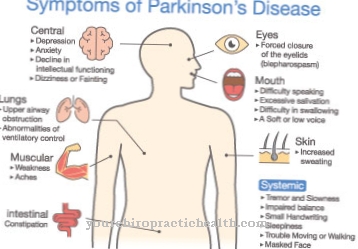A Optic nerve inflammation (technical language: Optic neuritis; also: Retrobulbar neuritis) is an autoimmune inflammation of the optic nerve (nervus opticus).
What is optic nerve inflammation?

© Alex - stock.adobe.com
It often occurs as an early symptom of multiple sclerosis, but it also occurs without this underlying disease. After a Optic nerve inflammation some optic nerve atrophy with reduced visual acuity may remain.
In the Optic nerve inflammation there is an autoimmune inflammation of the second cranial nerve (optic nerve). First, there is damage to the myelin sheaths, which electrically isolate the nerve and enable its high nerve conduction speed.
As the process progresses, the actual nerve fibers (axons) are also affected by the inflammation and can perish.
causes
The Optic nerve inflammation is a still poorly understood clinical picture. In 70% of cases, their cause remains unexplained. In the remaining 30% of cases, inflammation of the optic nerve is an early symptom of multiple sclerosis (MS).
This is a so-called demyelinating disease in which the myelin sheaths in the entire central nervous system (CNS) are destroyed by chronic inflammation. The etiology of MS has also not yet been clarified, despite great research efforts.
Optic nerve inflammation typically manifests between the ages of 18 and 45. The incidence is around 3 in 100,000 people. Women are three to four times more likely to be affected than men.
Symptoms, ailments & signs
Optic nerve inflammation can manifest itself through various symptoms. Initially, the disease is noticeable as increasing eye pain, which is localized behind the eyes and becomes stronger when the eyes are moved or pressure is applied. The pain is described as dull or throbbing, with discomfort worsening as the disease progresses.
In addition, there are visual disturbances, which in the further course can lead to complete blindness. A blind spot develops in the middle of the eye, which severely restricts the field of vision. In detail, the visual discomfort manifests itself in the fact that colors are only perceived as weakened and blurred into one another.
If the optic neuritis is based on multiple sclerosis, vision is impaired in the long term. In the meantime, eyesight can improve spontaneously, especially after acute flare-ups. Inflammation of the optic nerve also leads to headaches and dizziness, and occasionally nausea.
The actual inflammation causes general symptoms such as a slight fever and malaise. If the optic nerve inflammation is treated early, the symptoms will subside quickly. In the absence of treatment, chronic complaints can develop, and in extreme cases, one or both eyes can become blind. Optic neuritis typically affects only one eye.
Diagnosis & course
The first symptom of a Optic nerve inflammation is a rapid onset of visual acuity loss (loss of vision). The patients see blurred and have z. Sometimes slight pain or pressure when moving the eyes.
Headaches and the perception of flashes of light often occur. A temporary worsening of symptoms with increased body temperature, e.g. B. in the sauna, in the bathtub or during sports. In extreme cases, it leads to complete blindness. Optic nerve inflammation occurs on both sides in 7% of cases. The ophthalmological examination of the fundus may be normal; A swollen papilla is only visible in 35% of cases.
The diagnosis can be confirmed by magnetic resonance imaging (MRI), because demyelinating foci can be detected in the MRI. In addition to imaging procedures, CSF diagnostics provide indications of the presence of multiple sclerosis. Electrophysiological records can determine a reduced nerve conduction velocity. Otherwise, optic nerve inflammation is diagnosed solely on the basis of its clinical symptoms and its typical course.
Once onset, the inflammation usually lasts for 1-2 weeks and then shows spontaneous remission. No improvement is to be expected after 5 weeks. The extent of the damage that remains depends on the extent to which the inflammation had already affected the axons of the optic nerve. Because while myelin sheaths can regenerate, axons of the are usually irreparable.
95% of those affected achieve a visual acuity of at least 0.5 again after healing. 70% even achieve a visual acuity of at least 1.0 again after surviving optic nerve inflammation.
Complications
The most dangerous complication of optic nerve inflammation is complete blindness in the patient. In general, when the optic nerve becomes inflamed, eyesight deteriorates rapidly. This increases the risk of accidents and falls in everyday life and at work. If the inflammation spreads to other parts of the body, it can lead to infections in the nasopharynx, otitis media and, rarely, skin irritations with itching, swelling and redness.
Other complications depend on the cause of the inflammation. If the symptoms are based on multiple sclerosis, it inevitably leads to loss of vision. A papillite also results in loss of vision, although these are usually less severe. Retrobulbar neuritis can cause severe eye pain and temporary visual discomfort. Treating optic nerve inflammation also carries risks.
As part of cortisone therapy, side effects such as swelling and gastrointestinal complaints can occur. After taking antibiotics and antivirals, various complaints can occur - including headache, neck pain, muscle and limb pain, reddening of the skin and itching, and allergic reactions.Long-term use of these preparations results in permanent damage to the kidneys, liver and heart.
When should you go to the doctor?
Optic nerve inflammation should always be evaluated and treated by a doctor. Only with proper medical treatment can further complications that could prevent healing be excluded. A doctor should therefore be consulted at the first signs and symptoms of an inflammation of the optic nerve. A doctor should be consulted if the person concerned suffers from pain in the eyes. In most cases, this pain gets worse when the person moves their eyes or when the pressure on the eyes increases.
Sudden visual problems are also indicative of the optic nerve inflammation and must also be examined by a doctor if they persist for a long period of time for no particular reason. Many people who have optic nerve inflammation also suffer from fever, headaches and nausea. If the optic nerve inflammation is not treated, in the worst case scenario it can lead to blindness. The disease can be treated relatively well by an ophthalmologist.
Treatment & Therapy
Usually one forms Optic nerve inflammation spontaneously even without medical intervention. Drug therapy with high-dose steroids can shorten the duration of the optic nerve inflammation, but studies have shown that this does not improve the end result, i.e. that patients do not retain better visual acuity than without treatment.
Therefore, when talking to the patient, the disease abbreviation must be carefully weighed against the side effects of steroid therapy. If at least two demyelinating foci can be seen in the MRI, the administration of high-dose steroids should definitely be offered in order to delay new MS manifestations.
In the case of so-called atypical optic nerve inflammation, which does not show any improvement even after 4 weeks, an infectious background must be considered. Antibiotics and / or steroids can help here. If the optic nerve inflammation is based on multiple sclerosis, the underlying disease must of course be treated. There is no cure, but it can be delayed and alleviated.
You can find your medication here
➔ Medicines for visual disturbances and eye complaintsprevention
Since neither the Optic nerve inflammation Although the multiple sclerosis on which it is often based are fully understood, it is also unknown how this disease can be prevented. As a trigger of the non-MS-related optic nerve inflammation, however, u. a. chronic intoxication with alcohol, tobacco or quinine, various infectious diseases and arterial hypotension are discussed. In order to prevent optic nerve inflammation, these risk factors should be avoided.
Aftercare
Optic nerve inflammation must be completely cured. Follow-up care by the attending ophthalmologist ensures that the condition has been cured accordingly. First there is a patient interview. This clarifies whether the patient has symptoms and whether the prescribed medication causes side effects. Depending on the findings, the doctor can take further measures.
The aim of the anamnesis is to get as complete an overview as possible of the patient's state of health. As part of the physical examination, the affected optic nerve is examined by visual diagnosis and, if necessary, examined with further imaging procedures. Typical symptoms such as impaired vision, but also sensory disorders, must be clarified by the doctor.
An eye test can be used for this, if necessary. Follow-up care is usually carried out by the ophthalmologist who has already treated the optic neuritis. If complications arise during follow-up care, other specialists may need to be called in.
A chronic illness can indicate a viral disease, which must be clarified and treated by an internist. If there are other side effects, neurologists or ENT specialists can be involved in the treatment. Follow-up care is based on the severity of the inflammation and the symptoms.
You can do that yourself
An inflammation of the optic nerve has an enormous impact on the quality of life, as the patients suddenly perceive reduced vision and also suffer from pain in the eye area. In their own interest, those affected should help the disease to heal as quickly as possible. Otherwise long-term damage to the sense of sight is possible.
First of all, the medication prescribed by the doctor must be taken regularly. In the event of side effects, contact a doctor immediately or go to an emergency practice. Even if there are no complications, it makes sense to have medical check-ups. This allows the doctor to determine the status of the healing process and, if necessary, adjust the dose of the prescribed medication. In addition to taking the medicinal active ingredients, rest and protection play an essential role in accelerating healing. If possible, patients with optic nerve inflammation stay within their own four walls and stay in bed.
Protection is not only important for the immune system, but above all for the sense of sight. Under no circumstances should patients look at screens such as cell phones or computers. In addition, the eye must be protected from irritating influences such as wind, sharp food vapors, heat, cold and bright light. After consulting the attending physician, an eye patch or sleeping mask can be useful to allow the sick eyes sufficient rest.



























